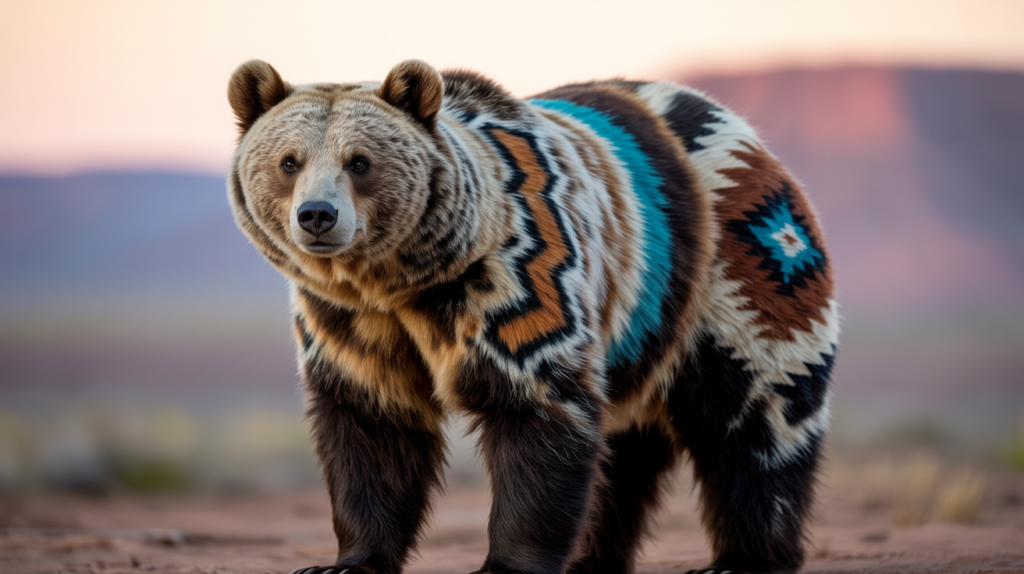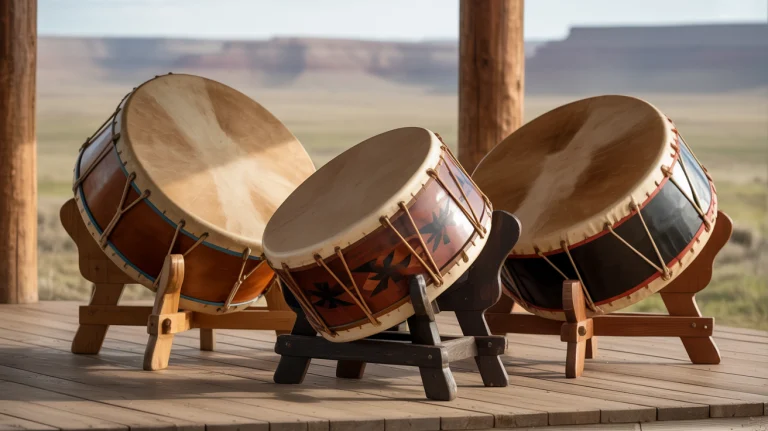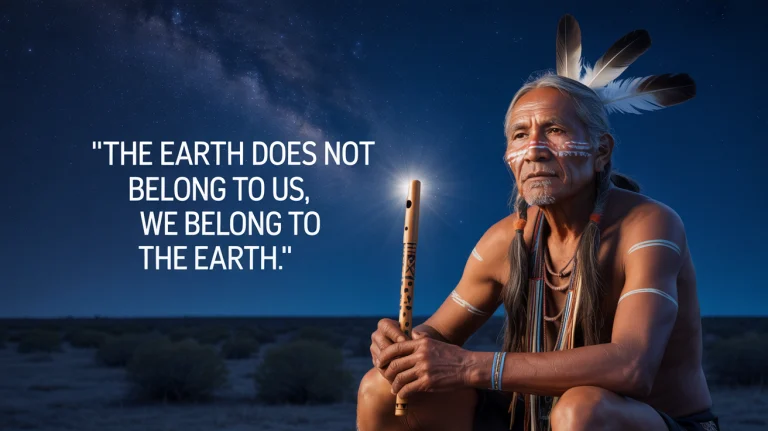The bear holds a position of profound reverence in Navajo culture, representing not merely a forest animal but a sacred being whose power, wisdom, and protective qualities have shaped Diné spiritual understanding for countless generations.
In the Navajo language, the word shash (shahsh) carries within it centuries of cultural knowledge about this magnificent creature, encompassing not only the literal animal but also the spiritual forces, clan connections, and ceremonial significance that make the bear one of the most important figures in traditional Navajo worldview.
Understanding how to say bear in Navajo language requires appreciating far more than simple vocabulary translation.
The word shash connects to complex networks of cultural meaning, ceremonial protocols, and traditional knowledge that demonstrate the sophisticated relationship between language, spirituality, and natural world understanding that characterizes Navajo culture.

Learning this single word opens pathways to deeper appreciation of indigenous wisdom about human-animal relationships and the sacred nature of all living beings.
The bear’s significance in Navajo culture extends from daily life observations to the highest levels of ceremonial practice, clan identity, and spiritual understanding.
Traditional stories, healing ceremonies, protective rituals, and clan affiliations all incorporate bear symbolism and invoke the powerful qualities that these animals represent within Diné cosmology and social organization.
For language learners, cultural students, and anyone seeking to understand the richness of Navajo traditional knowledge, exploring the word shash provides insight into how indigenous languages embed complex cultural wisdom within seemingly simple vocabulary.
This comprehensive examination reveals the layers of meaning that give Native American languages their extraordinary depth and cultural significance.
Throughout this exploration, we’ll examine not only the linguistic aspects of the word shash but also the cultural protocols, traditional stories, and contemporary relevance that make the bear a living symbol of strength, protection, and spiritual power within Navajo communities.
The Word Shash: Linguistic Foundation and Pronunciation

Basic Vocabulary and Pronunciation
The Navajo word for bear is shash (pronounced “shahsh”), though like many Navajo terms, this seemingly simple word carries complex phonological characteristics that require careful attention to proper pronunciation and cultural respect.
The initial consonant “sh” in shash represents a voiceless fricative that should be pronounced clearly and distinctly, similar to the English “sh” sound but with particular attention to Navajo phonological patterns that may differ slightly from English equivalents.
The vowel “a” in both syllables uses the low, central vowel quality typical of Navajo phonology, requiring clear articulation that distinguishes this word from similar-sounding terms in the language. Proper vowel quality is crucial for accurate communication and demonstrates respect for the language.
The final “sh” sound completes the word with the same consonant quality as the initial sound, creating a balanced phonological structure that reflects the harmony principles often found in Navajo linguistic patterns.
While the basic pronunciation appears straightforward, learners should seek audio examples from native speakers to master the subtle tonal and qualitative aspects that ensure respectful and accurate usage of this culturally significant term.
Dialectical Variations and Regional Usage
Regional variations in Navajo pronunciation may produce slight differences in how shash is articulated across different parts of the Navajo Nation, though the core phonological structure remains consistent and recognizable to speakers throughout Diné territory.
Some linguistic documentation includes alternative forms such as shaash with vowel lengthening or shush with different vowel quality, though these variations likely reflect either regional differences or specific contextual usage rather than completely separate words.
Contemporary speakers may show influence from English phonological patterns, particularly among younger community members, though traditional pronunciation remains the cultural ideal for formal usage and ceremonial contexts.
Understanding these variations helps learners appreciate the natural evolution of living languages while maintaining respect for traditional forms and the cultural authority of elder speakers who preserve ancestral pronunciation patterns.
Morphological Patterns and Word Formation
The structure of shash reflects common Navajo phonological patterns while also demonstrating the language’s capacity for creating words that embody cultural significance through their very sound patterns and morphological characteristics.
Compound formations involving shash create more specific terminology, such as shashtsoh (shash-tsoh) meaning “brown bear” or “big bear,” where the modifier “tsoh” (big/large) combines with the base term to create precise descriptive vocabulary.
Grammatical inflections can modify shash to indicate various grammatical relationships, possession patterns, and contextual usage that demonstrate the word’s integration into broader Navajo linguistic systems and cultural expression patterns.
The morphological behavior of shash in different grammatical contexts provides insight into how Navajo treats animal names and culturally significant terms within the language’s sophisticated grammatical framework.
Cultural Significance: The Sacred Bear in Navajo Tradition

Spiritual Power and Sacred Characteristics
Traditional Navajo understanding recognizes bears as beings possessed of extraordinary spiritual power that commands both respect and caution from humans who encounter them in natural settings or invoke them in ceremonial contexts.
The bear’s spiritual significance stems from observed characteristics including intelligence, strength, protective behavior toward offspring, healing knowledge through plant consumption, and seasonal patterns of hibernation and renewal that mirror important spiritual cycles.
Bears are often viewed as teachers and healers within traditional Navajo spirituality, with their behavior providing lessons about proper relationships with the natural world, seasonal adaptation, and the importance of balancing activity with rest and renewal.
The spiritual power attributed to bears requires specific protocols for discussing them, encountering them, and invoking their qualities in ceremonial contexts, with traditional knowledge governing appropriate behavior and respectful interaction.
Contemporary Navajo people continue to recognize bears as spiritually significant beings whose presence in traditional territory represents the ongoing vitality of ancestral relationships between humans and the natural world.
Clan Connections and Identity
The bear serves as the clan animal for the Towering House Clan (Kin Yaa’áanii), one of the major Navajo clans whose members maintain special relationships with bear symbolism and traditional knowledge related to these powerful animals.
Clan identity connected to the bear carries specific responsibilities for preserving traditional knowledge about bears, maintaining appropriate ceremonial protocols, and serving as cultural teachers about human-bear relationships within Navajo communities.
Members of bear-affiliated clans may have particular obligations regarding bear protection, traditional ecological knowledge, and the transmission of cultural teachings that preserve ancestral wisdom about these important animals.
The clan system’s incorporation of bear symbolism demonstrates how Navajo social organization integrates natural world relationships with human community structure and cultural identity formation.
Modern clan members continue to honor bear connections through cultural practices, traditional knowledge preservation, and contemporary conservation efforts that protect both the animals and their habitats.
Traditional Stories and Oral Literature
Bear narratives form an important category within Navajo oral tradition, with stories that teach cultural values, provide practical knowledge, and preserve spiritual understanding about these powerful beings.
Traditional bear stories often feature themes of respect, caution, healing, and the proper relationships between humans and powerful natural forces, providing cultural education through engaging narrative frameworks.
Many bear stories include specific protocols for human behavior when encountering bears, traditional knowledge about bear habits and seasonal patterns, and spiritual teachings about the power and wisdom that these animals possess.
The preservation of bear stories requires cultural protocols about when and how these narratives should be shared, with some stories reserved for specific seasons, ceremonial contexts, or educational situations that ensure appropriate cultural transmission.
Contemporary storytellers continue to share bear narratives while adapting traditional themes to address modern challenges including habitat conservation, cultural preservation, and the maintenance of respectful relationships with wildlife.
Traditional Ecological Knowledge and Bear Relationships
Seasonal Patterns and Natural Behavior
Traditional Navajo knowledge about bears encompasses detailed understanding of their seasonal behaviors, habitat preferences, and ecological relationships that demonstrate sophisticated environmental awareness developed through centuries of observation and interaction.
Spring bear activity patterns include emergence from hibernation, foraging behaviors, and territorial movements that traditional knowledge recognizes as important indicators of environmental conditions and seasonal timing for human activities.
Summer bear behaviors including feeding patterns, social interactions, and habitat usage provide information that traditional ecological knowledge incorporates into understanding of landscape health, resource availability, and appropriate human land use practices.
Autumn activities including intensive foraging, fat accumulation, and preparation for hibernation demonstrate natural cycles that traditional Navajo culture recognizes as models for appropriate seasonal adaptation and preparation practices.
Winter dormancy periods and denning behaviors provide examples of natural rest and renewal cycles that traditional culture incorporates into understanding of proper life rhythms and seasonal spiritual practices.
Medicinal and Healing Knowledge
Traditional Navajo knowledge recognizes bears as natural healers whose plant consumption patterns, seasonal behaviors, and physical characteristics provide important information for traditional medicine and healing practices.
Bear feeding behaviors, particularly their selection of medicinal plants and seasonal dietary patterns, have informed traditional knowledge about plant properties, preparation methods, and appropriate usage of natural medicines.
The bear’s seasonal cycle of activity and rest provides models for understanding human health patterns, appropriate timing for various activities, and the importance of balancing work with rest and renewal.
Traditional healing practices may incorporate bear symbolism, invoke bear protection, or use knowledge derived from observing bear behaviors to inform treatment approaches and ceremonial healing work.
Contemporary traditional medicine practitioners continue to honor bear-derived knowledge while adapting ancestral wisdom to address modern health challenges and changing environmental conditions.
Conservation and Environmental Stewardship
Traditional Navajo relationships with bears emphasize respect, appropriate distance, and understanding of ecological relationships that support both human and bear welfare within shared traditional territories.
Habitat protection practices derived from traditional knowledge help maintain environments that support healthy bear populations while also preserving the natural systems that sustain traditional Navajo lifeways and cultural practices.
Traditional protocols for human-bear interaction provide guidance for contemporary conservation efforts while maintaining cultural authenticity and respecting ancestral wisdom about appropriate relationships with powerful wildlife.
Contemporary Navajo conservation initiatives often incorporate traditional knowledge about bears with modern wildlife management approaches, creating integrated programs that serve both cultural and ecological preservation goals.
Practical Usage: Shash in Daily Communication
Basic Sentence Construction
Simple Navajo sentences incorporating shash follow standard grammatical patterns while demonstrating how animal terms function within the language’s sophisticated verb-centered structure and cultural communication patterns.
Díí shash (dee shahsh) means “this is a bear” and provides the basic pattern for identifying bears in immediate contexts, using the demonstrative pronoun “díí” (this) with the noun shash in a simple equational construction.
Shash yíyá (shahsh yee-yah) means “the bear is walking” and demonstrates how shash functions as a subject in sentences describing bear actions, using the verb “yíyá” (he/she/it walks) in third person singular form.
Shash bidziil (shahsh bee-dzeel) means “the bear is strong” and shows how descriptive statements about bears can emphasize their powerful characteristics using the adjective “bidziil” (strong/powerful).
Shash shił łaadoolá (shahsh shil lah-doh-lah) means “I saw a bear” and demonstrates how personal experience with bears can be described using appropriate verb forms and pronoun relationships.
Descriptive Vocabulary and Modifiers
Navajo provides various ways to describe different types of bears, their characteristics, and their behaviors through grammatical constructions that modify shash while maintaining cultural appropriateness and linguistic accuracy.
Shashtsoh (shash-tsoh) means “brown bear” or “big bear” and demonstrates how the modifier “tsoh” (big/brown) combines with shash to create specific terminology for different bear types or characteristics.
Shash yázhí (shahsh yah-zhee) could refer to a small bear or bear cub, using the diminutive modifier “yázhí” (small/little) to indicate size or age differences in bear descriptions.
Shash łizhin (shahsh lee-zhin) means “black bear” and shows how color terms can be combined with shash to create specific descriptive vocabulary for different bear varieties or characteristics.
These descriptive constructions demonstrate Navajo linguistic patterns while providing practical vocabulary for discussing bears in various contexts and situations.
Conversational Contexts and Cultural Protocols
Using shash in conversation requires understanding cultural protocols about when and how bears should be discussed, with traditional knowledge governing appropriate contexts and respectful communication patterns.
Family conversations about bears may emphasize safety, traditional knowledge transmission, and cultural education, with elders sharing bear-related wisdom and younger family members learning appropriate protocols for bear encounters.
Community discussions about bears often involve conservation concerns, traditional territory management, and the balance between human activities and wildlife protection that reflects traditional ecological knowledge and contemporary environmental challenges.
Educational contexts provide opportunities for sharing traditional knowledge about bears while teaching language skills and cultural values to younger generations who may have limited direct experience with these animals.
Ceremonial contexts may require special protocols for discussing bears, with specific language patterns and cultural procedures that ensure appropriate respect for the spiritual power and cultural significance of these animals.
Related Vocabulary: The Natural World Network
Animals and Wildlife Terms
Understanding shash within the broader context of Navajo animal vocabulary demonstrates how the language creates systematic relationships between different categories of wildlife and their cultural significance.
Naaldlooshii (nahl-dloh-shee) refers to animals in general, though this term also carries specific cultural meanings related to traditional beliefs that require careful attention to appropriate usage contexts and cultural protocols.
Náshdóí (nahsh-doy) means “wildcat” or “bobcat” and represents another powerful predator that shares certain characteristics with bears in terms of cultural significance and traditional respect patterns.
Ma’iitsoh (mah-ee-tsoh) means “wolf” and represents another large predator that, like bears, commands respect and features prominently in traditional stories and cultural knowledge systems.
Atse’hashké (at-say-hash-kay) means “crow” and demonstrates how different animal categories contribute to the complex network of traditional ecological knowledge and cultural symbolism.
Environmental and Habitat Terms
Bear habitat vocabulary provides essential context for understanding where and how bears live within traditional Navajo territory and contemporary conservation areas.
Dził (dzill) means “mountain” and represents the primary habitat where bears are typically found within traditional Navajo territory, connecting bear ecology to landscape understanding and traditional geographical knowledge.
Tsin (tsin) means “tree” or “forest” and describes the wooded environments that provide shelter, food, and denning sites for bears within their natural habitat requirements.
Tó (toh) means “water” and represents the essential resource that bears require and that influences their habitat selection and seasonal movement patterns.
Ch’il (ch-eel) means “plant” and refers to the vegetation that forms an important part of bear diets and influences their habitat preferences and seasonal behaviors.
Spiritual and Cultural Terms
Bear-related spiritual vocabulary connects shash to broader Navajo religious and ceremonial concepts that demonstrate the integration of natural world understanding with spiritual practices.
Diyin (dee-yeen) means “sacred” or “holy” and may be used to acknowledge the spiritual power and cultural significance that bears hold within traditional Navajo religious understanding.
Bidziil (bee-dzeel) means “strength” or “power” and represents one of the primary qualities associated with bears in traditional cultural understanding and spiritual symbolism.
Áhályááł (ah-hal-yahl) relates to protection and defense, reflecting the protective qualities that traditional culture associates with bears and their role in clan symbolism and spiritual practices.
Hózhǫ́ (ho-zhoh) means “harmony” or “beauty” and represents the balanced relationships between humans, bears, and the natural world that traditional culture strives to maintain.
Traditional Stories and Cultural Teachings
Bear as Teacher and Healer
Traditional Navajo narratives often feature bears as wise teachers who provide important lessons about survival, healing, and proper relationships with the natural world through their behavior and characteristics.
Stories about bear healing knowledge describe how observing bear behavior, particularly their use of medicinal plants and seasonal adaptation strategies, contributed to traditional Navajo medicine and health practices.
Bear hibernation cycles provide metaphors for important life lessons about the necessity of rest, renewal, and seasonal adaptation that traditional culture recognizes as essential for human well-being and spiritual development.
The bear’s protective behavior toward offspring demonstrates parental responsibility and family loyalty that traditional stories use to teach cultural values about proper relationships and social obligations.
Bear intelligence and problem-solving abilities feature in stories that emphasize the importance of careful observation, adaptive thinking, and respectful interaction with powerful natural forces.
Contemporary Relevance and Modern Applications
Modern Navajo communities continue to draw upon traditional bear stories and cultural knowledge while adapting ancestral wisdom to address contemporary challenges including habitat conservation and cultural preservation.
Educational programs in schools and cultural centers use traditional bear stories to teach both language skills and cultural values while connecting young people to their ancestral heritage and traditional ecological knowledge.
Conservation efforts within the Navajo Nation often incorporate traditional knowledge about bears with modern wildlife management approaches, creating comprehensive programs that serve both cultural and ecological goals.
Contemporary artists, writers, and cultural practitioners draw inspiration from traditional bear symbolism while creating new works that honor ancestral wisdom while speaking to modern experiences and concerns.
Modern Context and Conservation
Contemporary Bear-Human Interactions
Modern encounters between Navajo people and bears require balancing traditional knowledge and respect with contemporary safety concerns and wildlife management practices that protect both humans and animals.
Traditional protocols for bear encounters continue to provide valuable guidance for contemporary situations while being supplemented with modern safety information and wildlife management recommendations.
Habitat changes, climate impacts, and human development patterns create new challenges for maintaining traditional relationships between Navajo communities and bear populations within contemporary reservation environments.
Education programs work to maintain traditional knowledge about appropriate human-bear relationships while providing current information about safety, conservation, and coexistence strategies.
Language Preservation and Cultural Continuity
Contemporary efforts to preserve the word shash and related traditional knowledge reflect broader Navajo language revitalization initiatives that work to maintain cultural vocabulary and associated cultural understanding.
Educational programs emphasize teaching not just the word shash but also the cultural context and traditional knowledge that give this term its full meaning and significance within Navajo culture.
Digital documentation projects record elder knowledge about bears, traditional stories, and cultural protocols while making this information accessible to community members and future generations.
Community programs encourage intergenerational knowledge transmission by connecting elders who possess traditional bear knowledge with younger people interested in learning about their cultural heritage.
Frequently Asked Questions
How do you properly pronounce “shash”?
The Navajo word shash should be pronounced “shahsh” with clear articulation of both the initial and final “sh” sounds, using the low central vowel “a” quality typical of Navajo phonology.
The word should be spoken with respect for its cultural significance rather than casual pronunciation.
Both syllables carry equal stress, and the vowel quality should remain consistent between the two “a” sounds.
Learners should seek audio examples from native speakers to master the subtle qualities that ensure accurate and respectful pronunciation.
Regional variations may exist, but the basic “shahsh” pronunciation remains recognizable throughout Navajo territory and represents the standard form used in educational and cultural contexts.
What is the cultural significance of bears in Navajo tradition?
Bears hold profound spiritual significance in Navajo culture as powerful beings associated with healing, protection, strength, and wisdom.
They serve as clan animals for certain Navajo clans and feature prominently in traditional stories, ceremonies, and spiritual practices.
Traditional knowledge recognizes bears as teachers whose behavior provides important lessons about seasonal adaptation, healing practices, and proper relationships with the natural world.
Their intelligence and protective behavior toward offspring make them important symbols in cultural education.
The spiritual power attributed to bears requires specific protocols for discussing them and interacting with them, reflecting traditional understanding of their sacred nature and the respect they deserve as powerful spiritual beings.
Are there different words for different types of bears?
While shash serves as the general term for bears, Navajo creates specific terminology through compound constructions such as shashtsoh (big bear/brown bear) and shash łizhin (black bear) that provide more precise descriptive vocabulary.
These compound forms follow standard Navajo morphological patterns where modifying elements combine with the base term to create specific meanings while maintaining the cultural significance of the root word shash.
Regional knowledge and traditional ecological understanding may include additional descriptive terms or specific references to bear characteristics, behaviors, or habitats that reflect local environmental conditions and cultural knowledge.
How should non-Navajo people use this word respectfully?
Using shash respectfully requires understanding its cultural significance and appropriate contexts rather than treating it as casual vocabulary for general use.
Learning should occur within educational frameworks that include cultural context and respect for Navajo traditions.
Appropriate usage involves understanding when and how the word should be used, seeking guidance from Navajo speakers and cultural practitioners, and ensuring that usage demonstrates genuine respect for the cultural knowledge and spiritual significance embedded in the term.
Educational contexts, cultural learning programs, and respectful cross-cultural dialogue provide appropriate venues for learning and using this word while supporting Navajo language preservation and cultural education efforts.
Conclusion: Honoring the Sacred Bear
The Navajo word shash represents far more than simple vocabulary for identifying an animal—it embodies centuries of cultural wisdom about the sacred relationships between humans and the powerful beings who share our world.
Understanding this single word opens pathways to appreciating the sophisticated ecological knowledge, spiritual understanding, and cultural values that characterize traditional Navajo relationships with the natural world.
Learning to properly pronounce and respectfully use shash connects us to ongoing efforts to preserve indigenous languages and the irreplaceable cultural knowledge they contain.
Each person who approaches this learning with genuine respect contributes to the vitality of Navajo linguistic heritage while gaining insight into indigenous wisdom about human-animal relationships.
The bear’s significance in Navajo culture—from clan identity and traditional stories to ceremonial practices and contemporary conservation efforts—demonstrates how indigenous cultures maintain sophisticated understanding of ecological relationships while honoring the spiritual dimensions of natural world interactions.
For language learners, cultural students, and anyone seeking to understand indigenous perspectives on wildlife and environmental stewardship, the word shash provides essential insight into how traditional knowledge systems integrate practical understanding with spiritual respect and cultural responsibility.
As we learn to recognize and honor the sacred nature of bears through traditional Navajo understanding, we participate in preserving cultural knowledge that offers essential guidance for creating respectful relationships with the natural world while supporting the communities that have maintained these precious traditions through centuries of challenge and change.
The enduring power of shash lies not only in its linguistic function but in its capacity to connect us to ancient wisdom about respect, protection, and the sacred nature of all living beings—teachings that remain as relevant today as they were for countless generations of Diné people who have honored the bear as teacher, protector, and spiritual guide.
Source: MC Archive
Related Post: Navajo Language






